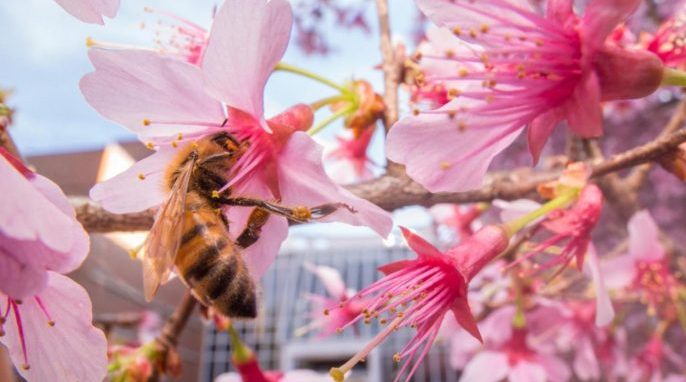By Kate Stone
Urban bees have access to soft drinks, candy, and other sweet junk food, but bees don’t want our processed sugars. Instead, they stick to a diet of flower power. But are there enough flowers in cities to satisfy the bees?
Researchers at North Carolina State University have found that urban bees stick to a flower nectar diet and don’t eat the processed sugars found in our sodas and junk food.
“Urban habitats are growing, as is urban beekeeping, and we wanted to see if bee diets in cities are different from those in rural areas,” says Clint Penick, a postdoctoral researcher at NC State. “For example, we wanted to know if there are even enough flowers in urban areas to support bee populations, or if bees are turning to human sugar sources, like old soda.”
Don’t Honeybees Like Sugar Water?
When flowers are in short supply, beekeepers often supplement their bees’ flower nectar diet with sugar water. For this reason, the research team thought that domesticated bees would get a lot of their calories from processed sugar—especially urban honeybees that have easy access to plenty of processed sugar left over in soda cans and other trash left outside.
Contrary to the predictions, the researchers discovered that urban honeybees didn’t eat any more processed sugar than rural bees. However, domesticated bees showed evidence of consuming significantly more processed sugar than bees living in the wild.
What Does It Mean?
Honeybees favor natural food sources that keep them happy and healthy. In fact, various plants provide bees with their own nature-made medicine cabinet, as this article explains.
“Basically, bees are relying on flowers in cities and are not turning to human foods to supplement their diet,” Penick says. “This is good news for urban beekeepers. The honey in their hives is mostly coming from flower nectar and not old soda.”
How Can We Help Urban Honeybees?
If city populations are growing and urban honeybees prefer flower nectar to leftover soda, are there enough flowers to sustain the bees? This study suggests that, at least in midsized cities, there probably are. However, it is not yet known if this result holds true for the biggest cities.
“Our findings are based on research in a midsized city,” Penick says. “Even the most urban areas of Raleigh have more than 50 percent open green space. By comparison, the average site in New York City has only 10 percent green space. So more work needs to be done to evaluate bee diets in our largest cities.”
City dwellers can help battle bee population decline by growing bee-friendly flowers and buying local produce from growers who support sustainability and biodiversity. Providing natural food sources for bees in winter, as well as in summer, is also important.
The paper, “The Contribution of Human Foods to Honey Bee Diets in a Mid-Sized Metropolis,” is published online in the Journal of Urban Ecology. The paper was coauthored by NC State’s Catherine Crofton, Holden Appler, Steven Frank, Rob Dunn, and David Tarpy. The work was supported by the NC State Beekeepers Association, the North Carolina Department of Agriculture and Consumer Services, the US Geological Survey under cooperative agreements G11AC20471 and G13AC00405, and the CALS Dean’s Enrichment Grant.
Image courtesy of Lauren Nichols
GotScience.org translates complex research findings into accessible insights on science, nature, and technology. Help keep GotScience free: Donate or visit our gift shop. For more science news subscribe to our weekly digest.

